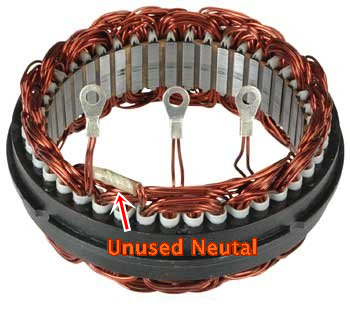
 
     |
| Alternator replacement/upgrade (Page 1/1) |

|
1TrueJeff
|
MAY 10, 07:36 PM
|
|
Greetings all.
I have finally faced my first real issue with my inherited fiero. The alternator appears to be dead. My question is this. Local auto parts store offers several amperage options, all allegedly fitting onto my 85 se iron duke. Is there any point to getting one of the higher amperage ones? I believe I have the 72 amp version, however, if I am already going to be buying a new one, is there any real reason to buy the 100 or 150 amp one? My father was always the person I consulted about part stuff, so I'm just trying to get a second opinion.
Thanks for the input!
-1TrueJeff
|
|

|
hunter29
|
MAY 10, 07:54 PM
|
|
|
Do you have a need for a higher output?
|
|

|
1TrueJeff
|
MAY 10, 09:13 PM
|
|
|
Not at the moment, but if I'm going to replace it shouldn;t I get one that is a bit more well equipped for some more electrical components?
|
|

|
hunter29
|
MAY 10, 09:24 PM
|
|
|
Perhaps, I’ll look forward to what others say..
|
|

|
theogre
|
MAY 11, 12:32 PM
|
|
Test alt at any local parts stores because "Dead Alt" is often a wiring problem to it.
If passes look for iffy side plug, bad bulb in dash and other wiring problems.
If they say Dead Alt then...
Have "extra" power from the Alt isn't bad or good...
First See my Cave, Watt Story
Installing SI12 claim 100+ amps often eats more engine power just to spin before makes 1 amp then OE GM SI12 units or CS130.
SI12 and related have problems even when rewired to have more amps then GM offered.
A lot of people here and elsewhere have Upgraded to CS130. While some claim CS130 "sucks" because they have no clue. GM still use CS alts for several reasons w/ highlights in the cave. New GM Alt's may have different names attach to them because how their wired and control/monitor by ECM/PCM but basically same parts to generate power to get steep curve of power generated on output terminal.
Plus CS units have Rewired them to Eliminate the Diode Trio in the SI units the fails and often destroys the battery. That part is Gone, Not "Buried" in the regulator or diode set. Way too many old GM cars before ~ 87 model year had this problem...------------------
Dr. Ian Malcolm: Yeah, but your scientists were so preoccupied with whether or not they could, they didn't stop to think if they should.
(Jurassic Park)
The Ogre's Fiero Cave
|
|

|
greenturnedblue
|
MAY 13, 02:49 AM
|
|
|
Hi Ogre, could you please elaborate on how a failed diode trio can destroy the battery? How can this happen? Thanks
|
|

|
theogre
|
MAY 13, 05:21 PM
|
|
| quote | Originally posted by greenturnedblue:
Hi Ogre, could you please elaborate on how a failed diode trio can destroy the battery? How can this happen? Thanks |
|
The Diode Trio often fails and often Drains the battery to "Zero" in Hours. True Zero can take a little more time. If you find out before that, car batteries get damage every time pulls down < 10-11 volts. You might charge a low or dead battery but damage is permanent and need a new battery very soon at best.
In fact car Starting Batteries can get problems even < ~ 11.5 volts for car w/ charging problems or not drive enough to charge. Deep Cycle types often get damage < 10 to 9 volts. (Is why Many use Battery Tender etc for cars not driven for a week or more.)
See my Cave, Battery
Same damage is done by HL etc left On when parked until car won't start.
Even "Small" things like say a Dash Cam left On can kill the battery but just takes longer.
SI and CS Stators are made different even tho look similar to most people and CS doesn't use the Diode Trio because of this.
In Very Short Tech Terms...
The Stator Coils are 3 Phase AC Output and can be wire as 4 terminal Y, 3 terminal Y and Delta. 12SI and most SI are 3 term Y and require the Diode Trio for the regulator to work. CS use Delta and doesn't need the extra diodes.
If you look careful at 12SI Stator picture at many part outlets, you often see a wire joint "taped" near the 3 output terminals. This joint is where all 3 coils joined in Y config. Example:
 Original base image at https://store.alternatorparts.com/12si-stator.aspx Original base image at https://store.alternatorparts.com/12si-stator.aspx
I'm not sure if anyone uses 4 term Y in car alt's. Maybe too much noise or other problems for making final DC output. I'm not digging thru many books etc to find a 4 terminal Y stator for cars.
E2A5/14--> From old notes and little digging later... Ford G series and other use "4 term Y" w/ Rectifiers made for that. Some Stators have 4 terminal. Others like Ford have 6 outs, 2 for each coil, and "splice" them in the Rectifier assembly to access the Neutral. However actually wired, Result don't need the Diode Trio like GM SI.
GM did have problems w/ OE CS but most rebuilders and new units have better bearings etc. If have room could use "Iceburg" case sold thru alternatorparts.com to give more heat removal from the rectifier.[This message has been edited by theogre (edited 05-14-2022).]
|
|
    
  |
|















